MARIANI’S
January
4, 2009
NEWSLETTER
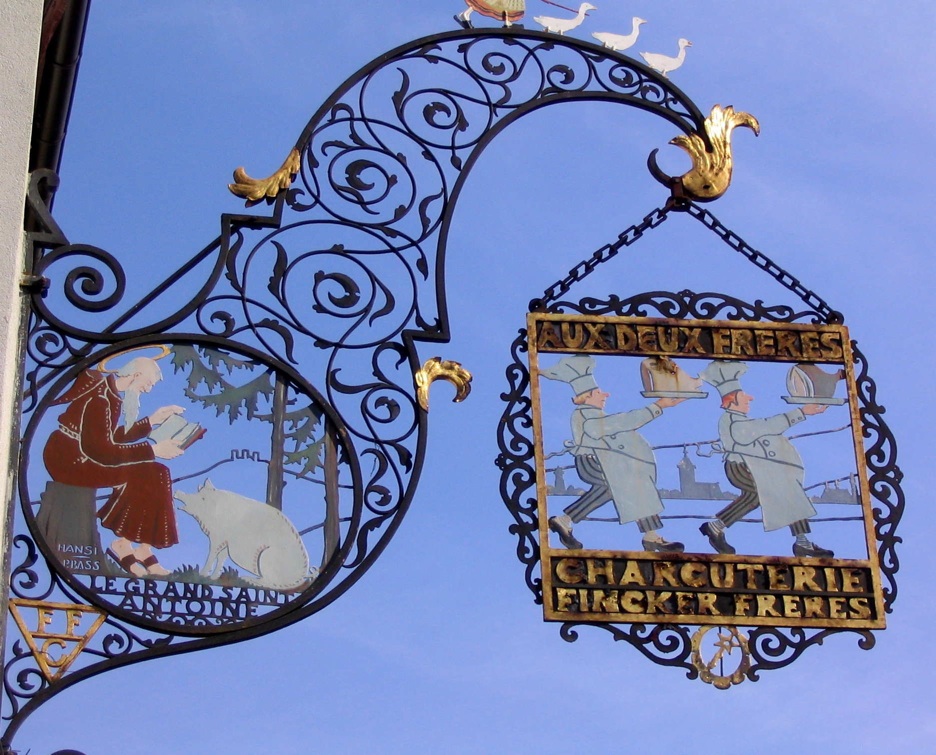
Aux Deux Frères
Charcuterie, Alsace (2006). Photo by Galina Stepanoff-Dargery
~~~~~~~~~~~~~~~~~~~~~~~~~~~
SUBSCRIBE AND
UN-SUBSCRIBE: You may subscribe anyone you wish
to this newsletter--free of charge--by
clicking here.
To Read my
article on Dining Out in Santa
Fe, NM,
in this month's Diversion
Magazine, click
here.
In
This Issue
NEW YORK CORNER: COMMERCE by John Mariani
NOTES FROM THE WINE CELLAR: Blanc de Blancs Champagnes by John Mariani
QUICK BYTES
~~~~~~~~~~~~~~~~
Dining
Out
in Copenhagen by John Mariani
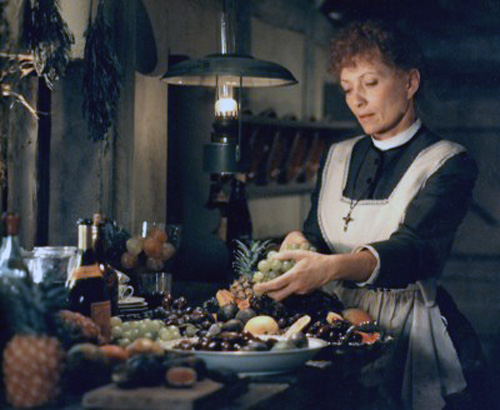
Some
decades ago Scandinanavian food was very much a part of American
gastronomy, with numerous Danish, Swedish, and Norwegian restaurants in
New York, Chicago, and cities like Minneapolis where Scandinavians
settled in the 19th century. Even into the 1960s Swedish
meatballs and Danish pastry were staples of the American party table.
Now, there is next to nothing left of those food traditions in the
U.S., so that most people couldn't really describe what Danish food is,
unless they've seen the movie 1987 "Babette's Feast" (right), which seemed to consist of
nothing but dried cod and bread-and-ale soup until Babette prepared a
spectacular classic French dinner for the townsfolk.
But like all food cultures in Europe over the last
decade, Danish cuisine has taken salient leaps into a modernity sprung
from tradition, so that the heaviness that once marked the Danes'
gastronomy has given way to new interpretations while accepting global
ideas that make perfect sense on their menus, not least when it comes
to seafood. On my recent trip to Copenhagen I found an array of foods
and styles of restaurants that could as easily be found at New York's
well-regarded Aquavit--one of the few Scandinavian restaurants left in
the U.S. There are now ten Michelin stars in
Copenhagen, including NOMA, The Paul in Tivoli Gardens, and MR, and a
brigade of young chefs have incorporated everything
from pasta to sushi in their cooking.
Incidentally, the waitstaff at every
restaurant I visited was always friendly, very knowledgeable, and, as
I've noted before, wholly fluent in English. And
remember: tax
and service are all included in the menu prices, and there is no
tipping
in Copenhagen.
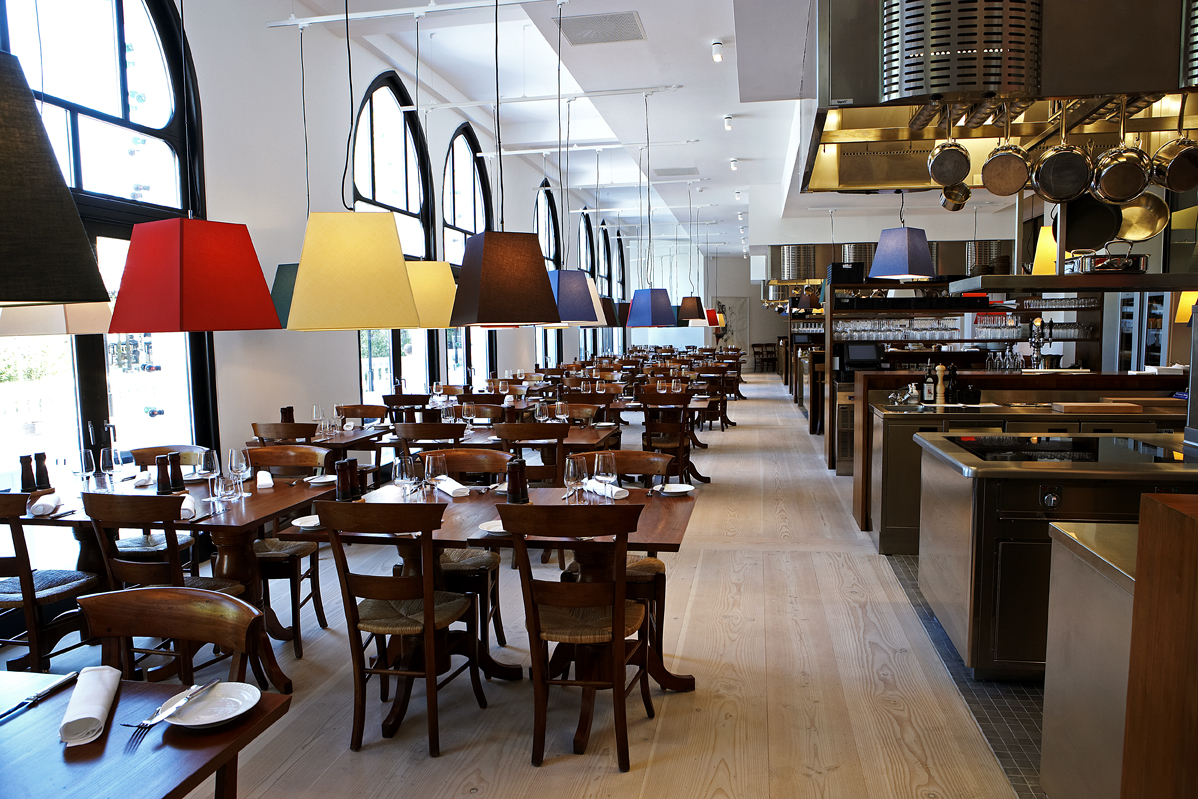 Also
in
Tivoli is a delicatessen with its own retail dairy and bakery that
supplies
their formal uptairs Restaurant Herman,
which specializes in classic Danish cuisine, and the casual brasserie
called Nimb, where the open stoves are set
right across from the big wooden tables (left) that afford a wonderful view
of
the Gardens. When I visited Nimb it was December so the menu was
featuring winter specials like sautéed foie gras with glazed
figs in
balsamic vinegar on buttery toasted brioche; pink, roasted breast of
duck and creamy rillettes with
a crispy
potato fondant, and tangy red cabbage braised in
orange juice; and a Danish Christmas spcial--ris
à l'amande, which is a rich
rice pudding with cherry jelly and dried cherries on French toast
caramelized with gingerbread spices and a mulled wine sorbet--quite a
triumph of tradition wed to modern culinary ideas. Good winelist,
too, at Nimb, with some very reasonable regional global wines.
Also
in
Tivoli is a delicatessen with its own retail dairy and bakery that
supplies
their formal uptairs Restaurant Herman,
which specializes in classic Danish cuisine, and the casual brasserie
called Nimb, where the open stoves are set
right across from the big wooden tables (left) that afford a wonderful view
of
the Gardens. When I visited Nimb it was December so the menu was
featuring winter specials like sautéed foie gras with glazed
figs in
balsamic vinegar on buttery toasted brioche; pink, roasted breast of
duck and creamy rillettes with
a crispy
potato fondant, and tangy red cabbage braised in
orange juice; and a Danish Christmas spcial--ris
à l'amande, which is a rich
rice pudding with cherry jelly and dried cherries on French toast
caramelized with gingerbread spices and a mulled wine sorbet--quite a
triumph of tradition wed to modern culinary ideas. Good winelist,
too, at Nimb, with some very reasonable regional global wines.
Nimb
charges 345DKK for two courses (about
$66), 395DKK for three ($76), and 435DKK ($83) for four.
A less modern--though very new--place for a cozy
dinner is Les Trois Cochons, which is
run by a restaurant 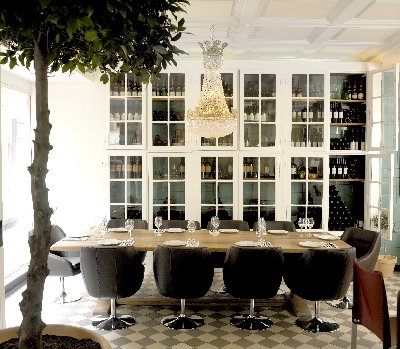 company
named Cofoco with several styles of eateries around town. With
its glass-fronted wine shelves (right),
butcher tiles, simple settings, and bistro-style menu at 275 DKK, Les
Trois Cochons (the three pigs) is
a popular spot and a fairly romantic one for its low
candlelighting, bare wooden tables, and intimate size. As
in many
casual Copenhagen restaurants, paper napkins are the rule, which is
pretty chintzy.
company
named Cofoco with several styles of eateries around town. With
its glass-fronted wine shelves (right),
butcher tiles, simple settings, and bistro-style menu at 275 DKK, Les
Trois Cochons (the three pigs) is
a popular spot and a fairly romantic one for its low
candlelighting, bare wooden tables, and intimate size. As
in many
casual Copenhagen restaurants, paper napkins are the rule, which is
pretty chintzy.
There isn't a great deal of choice on
the small menu, which changes often, but more than enough for a couple
to
enjoy, starting off a generous selection of the chef's hors d'oeuvres
of the
evening, some charcuterie, and, as everywhere in Copenhagen, good
bread. Salmon comes with mussels and
fennel scented with Pernod, and I thoroughly enjoyed a richly fatted
duck confit with
red cabbage, sweet prunes, and its own reduction for gravy. An
entrecote
of beef was chewy beyond what bistro steask should be, served with foie
gras, Jerusalem artichoke and a Port reduction. The chef then
sends out his "gourmandise" of desserts.
Somewhat
more adventurous and a whole lot larger is the restaurant SALT,
located in the historic Admiral Hotel
and done up like everything there
in bold angles of wood beams, teak, deep marine blue colors, and
soft chiaroscuro lighting, allowing you to peer through the windows to
the
twinkling lights of the harbor. The 100-seat dining room (below) was designed by London's
Conran & Partners (they have three other nearby restaurants),
with nicely spaced tables (the room also serves an extensive
breakfast
buffet in the morning). The winelist is excellent at SALT.
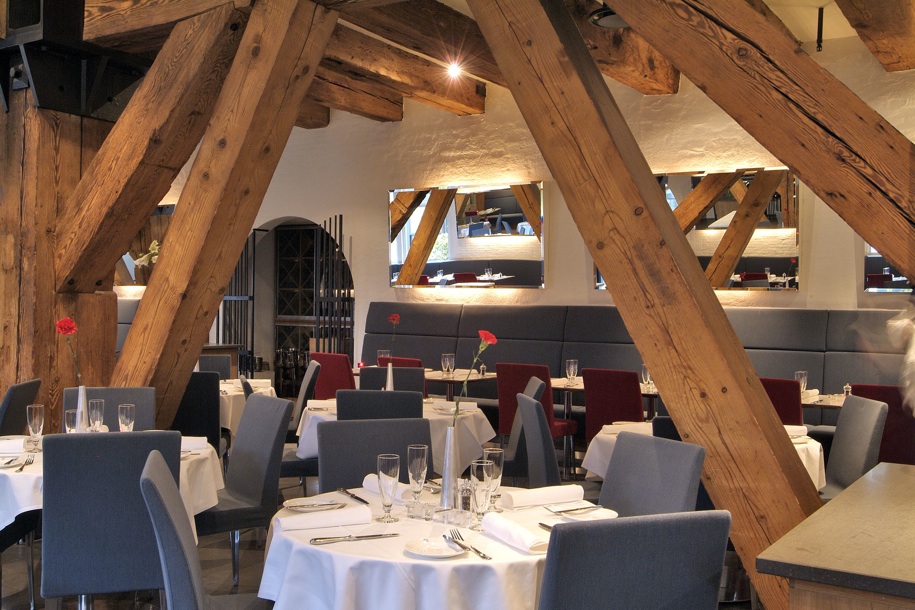 We
began with a dish of fried scallops with pumpkin, cardomon, and vanilla
crumble--nicely creative, with subtle flavors and textures, evocative
of the spice routes Danish sailors plied. Poached saddle of a
remarkably fat rabbit came with white cabbage and parsley. Curiously
enough, the main courses included yet another fried seafood--monkfish,
this
time--with pickled calf's tongue, warm potato salad, and leek, which
harkened back to Scandinavian roots,. Roasted leg of venison with
a not-too-intense black blood pudding, apple, and Jerusalem artichoke
was an ideal winter's dish. There was also a
hearty tenderloin of pork marinated in beer then roasted, with a
braised shank
and yellow split pea soup.
We
began with a dish of fried scallops with pumpkin, cardomon, and vanilla
crumble--nicely creative, with subtle flavors and textures, evocative
of the spice routes Danish sailors plied. Poached saddle of a
remarkably fat rabbit came with white cabbage and parsley. Curiously
enough, the main courses included yet another fried seafood--monkfish,
this
time--with pickled calf's tongue, warm potato salad, and leek, which
harkened back to Scandinavian roots,. Roasted leg of venison with
a not-too-intense black blood pudding, apple, and Jerusalem artichoke
was an ideal winter's dish. There was also a
hearty tenderloin of pork marinated in beer then roasted, with a
braised shank
and yellow split pea soup.
Desserts included a pleasant citrus cake with
lemon mousse and browned butter.
The
appetizers ranged from 110 DKK-115 DKK,
main courses 240 DKK-275 DKK.
One of the most striking upsale
restaurants in Copenhagen is Alberto K in the SAS
Royal Hotel, which has for decades retained its Arne Jacobsen
décor
from the 1960s (one guestroom, number 606, has been left completely as
it was then), which had a significant influence of the interior design
of modern hotels. 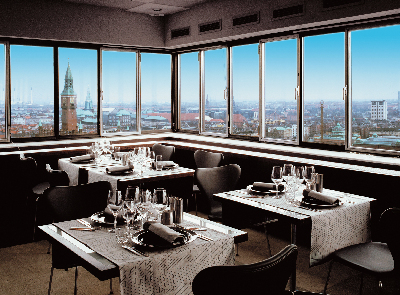 At
the top is the restaurant, on the 20th floor (right), with a marvelous view of
the city, and here, too, the dining room reflects the clean linear work
of Jacobsenian design. The name of the dining room commeorates the
dedication of its
former manager, Alberto Kappenbergers, whose portrait graces one wall;
the rest are glass, the tablesettings exquisite, and chairs
quintessential Danish modern.
At
the top is the restaurant, on the 20th floor (right), with a marvelous view of
the city, and here, too, the dining room reflects the clean linear work
of Jacobsenian design. The name of the dining room commeorates the
dedication of its
former manager, Alberto Kappenbergers, whose portrait graces one wall;
the rest are glass, the tablesettings exquisite, and chairs
quintessential Danish modern.
Alberto K is very much committed to
contemporary Scandinavian cuisine based on all that can be gleaned crom
the
seas and land, so we bagan our meal with langoustines from
Læsø with a
sweet-pickle mustard, radish, pancetta ham, and onion, served with a
glass of
delicious Paolo Scavino Sorriso wine from the Langhe. North sea cod and
celery swam in a browned butter cream of salt cod with hazelnuts,
watercress, fennel, and sweet cicely, accompanied by Marziano Abbona
Cinrino from Dogliano.
The man courses was wild duck with a fine gamey
flavor that was enhanced by morel mushrooms, with apples and something
translated as "roots from
Wiuff" and apples; the wine, a syrah Il Bosco from Tenimenti Luisig
d'Alessandro from Cortona. Medjool dates with limoncello and chocolates
finished the evening with a glass of Frescobaldi Pomino. Alberto K
stocks one of the finest wine cellars in the city, and these Italian
gems are among the best priced.
Four
courses here run 600DKK, accompanying
wines, 535DKK.
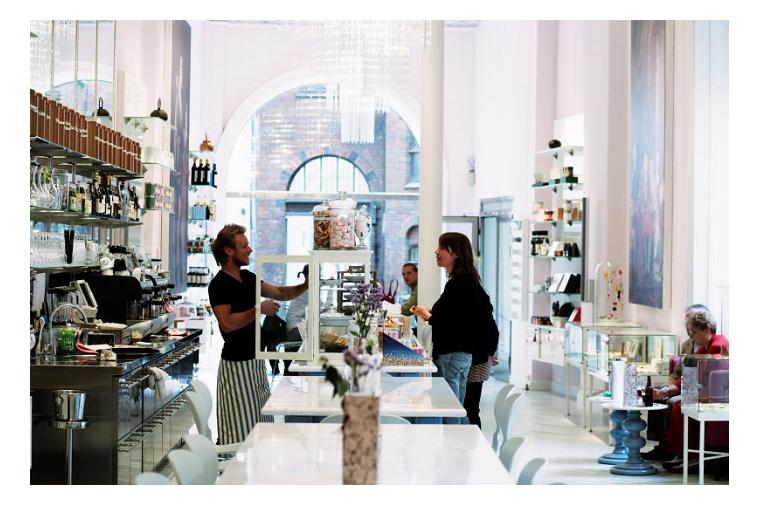 A bright
new idea in Danish cuisine has taken on the
international colloquialsm "Smushis," served in profusion--several on
one plate--at the Royal
Café attached to the Royal Copenhagen
design and retail store. It's a long, sunny, fanciful and pretty
room (left), rather feminine,
with some high white marble tables where you sit and order your choice
of dozens of
small versions of the traditionally huge open-faced sandwiches called smørrebrød,
which are longtime staples of a Danish lunch. Smushis are
lighter, more global in their ingredients, and artfully crafted so that
you can easily eat four or five of them with a glass of Danish beer,
and be out the door happy and not much poorer for the afternoon.
A bright
new idea in Danish cuisine has taken on the
international colloquialsm "Smushis," served in profusion--several on
one plate--at the Royal
Café attached to the Royal Copenhagen
design and retail store. It's a long, sunny, fanciful and pretty
room (left), rather feminine,
with some high white marble tables where you sit and order your choice
of dozens of
small versions of the traditionally huge open-faced sandwiches called smørrebrød,
which are longtime staples of a Danish lunch. Smushis are
lighter, more global in their ingredients, and artfully crafted so that
you can easily eat four or five of them with a glass of Danish beer,
and be out the door happy and not much poorer for the afternoon.
Brunch is 150 DKK, while 3 smushis cost 125
DKK (45 DKK per piece), and they also serve terrific desserts here.
It's a concept the brand hopes to take worldwide, starting in, of all
places, Japan; then again, the smoked and fresh fish and the spicy
condiments, pickles, and roe should do very well way over there.
If you wish
to read Part One of this report
on Copenhagen, click here.
NEW
YORK CORNER
by
John Mariani
Photos by Katherine Bryant
50 Commerce Street
212-524-2301
www.commercerestaurant.com
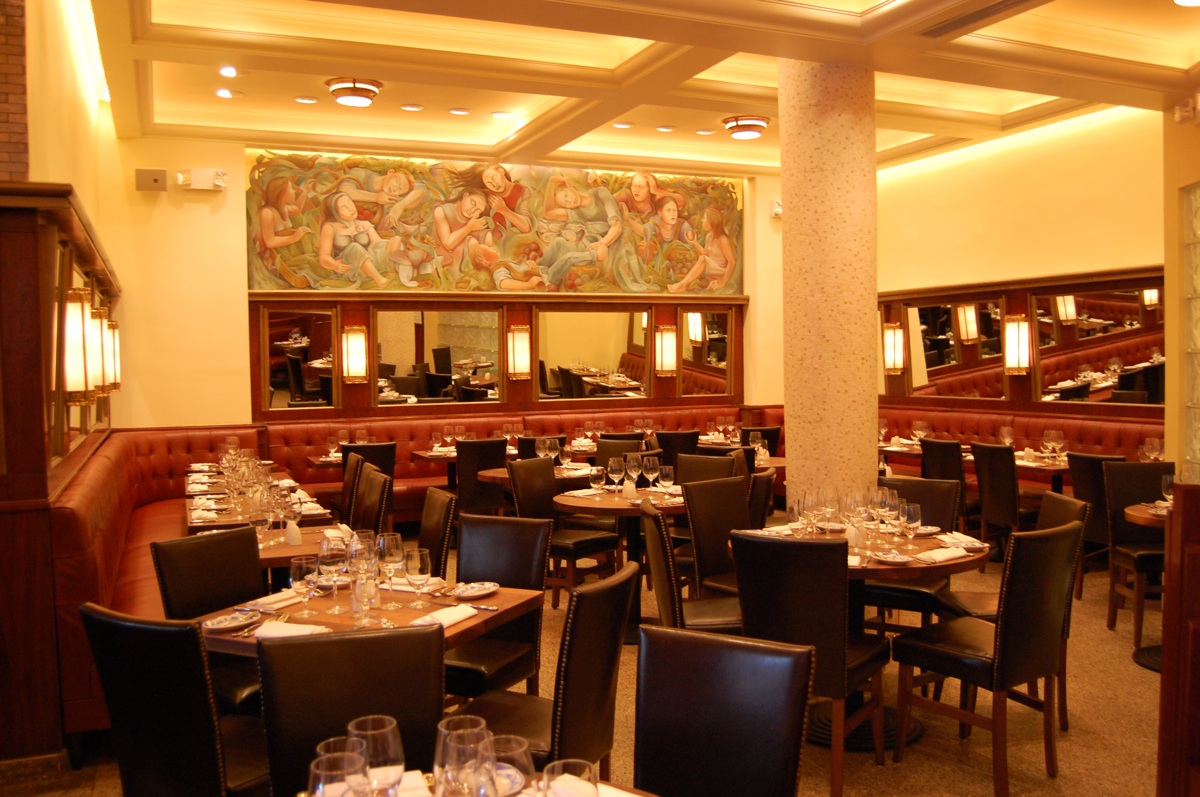 Of
all Greenwich Village streets, narrow, tiny Commerce,
almost a
cul-de-sac, is
perhaps the loveliest. It reminds me of the old Warner Bros.
backlot streets of the 1930s or of an Edward Hopper painting, with a
hazy sunlight falling on red brick.
Of
all Greenwich Village streets, narrow, tiny Commerce,
almost a
cul-de-sac, is
perhaps the loveliest. It reminds me of the old Warner Bros.
backlot streets of the 1930s or of an Edward Hopper painting, with a
hazy sunlight falling on red brick.
At the end of it sits a quite
historic restaurant of the same name, once a speakeasy, then called
Blue Mill and later Grange Hall. All the lineaments of the space have
been lovingly respected and refined, with chestnut booths, subway
tiles, terrazzo floors, and a reclaimed 1940s art deco Brunswick bar.
Recently added, two superb murals (left)
by David Joel called “A
Common Ground for Sisters’ Story”--a symbolic rendering of the story of
two sisters whose sea captain father connected two townhouses by a
garden in order to bringing his irascible daughters closer.
The current occupant, Commerce's owner Tony Zazula,
formerly
of Montrachet, has taken on
Chef Harold Moore as partner, also a Montrachet grad, to create a menu
that, while
not really indicative of what would have been served 60 years ago here,
does
have a kind of old-fashioned, homey flavor to it all.
Mixing Italian,
French, and American ideas and dishes, the menu hangs together
extremely well, with little on it that seems extraneous or out of
character. Chef de cuisine is Snir Eng-Sela.
The breadbasket should tell you something: All
of the offerings in it are irresistible--ciabatta, olive, French
and, not least, the fat soft pretzels are delicious on their own
but also good for mopping up the duck and foie gras rillettes with
black
cherry shallot jam and the "ragù of odd things," meaning oxtail,
pig's trotter and tripe with hand-rolled orrecchiette. Spaghetti
carbonara is made wisely, with lots of black pepper and a
coddled
egg you mix in to cook with the pasta's heat, while fettuccine with
"one-hour tomato sauce" and housemade ricotta was a simple beauty of a
dish. A starter of calf's liver was a little chewy
that night and needed sweeter caramelized onions. If you
wish to go light, have the delightful 20-herb salad with Manchego
cheese, olive oil and lemon.
The night's special--which I wish they had
every night!--was Prime rib of beef, succulent and medium rare, with
Yorkshire pudding in a little casserole. I only wish they'd also
served me the bone to gnaw on (I asked but no go): some of the best
meat clings to it. A
red snapper with eggplant and charred scallions in a Thai-inpsired herb
broth was a little out of the ordinary here but delicious nonetheless.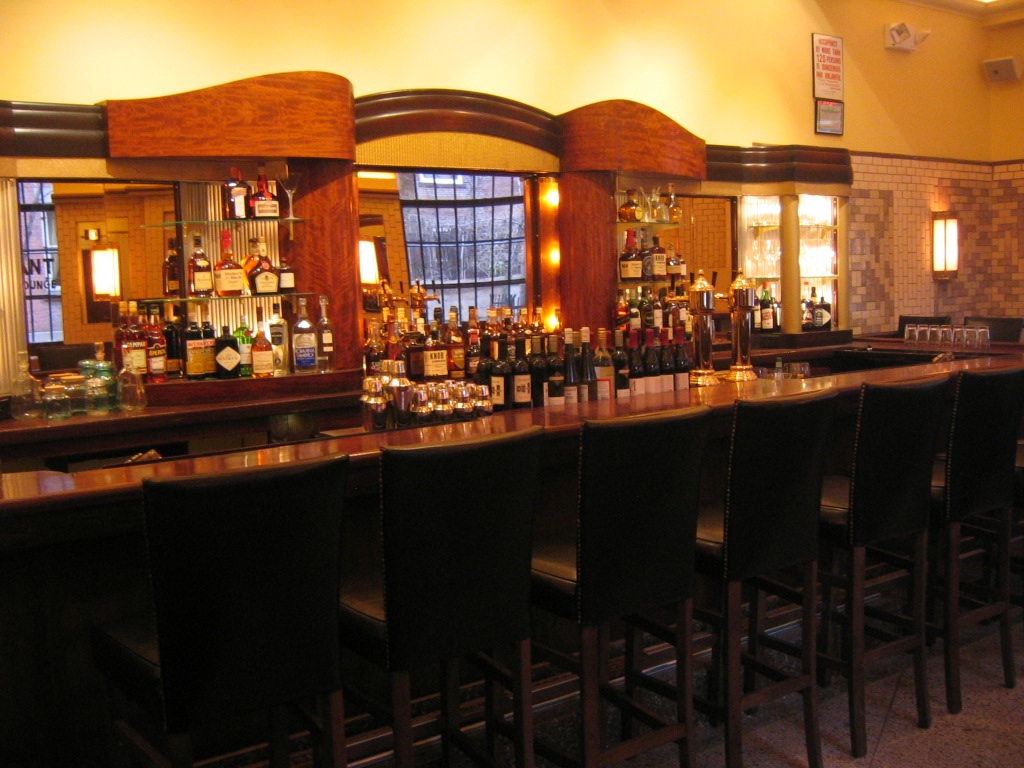
Two people must share the roast chicken,
as
good and moist as most in New York, with a foie gras-bread stuffing and
potato mousseline that could have used more butter.
New York pastry chefs rarely miss
a step, and Commerce offers some splendid sweets, including
chocolate-hazelnut mille
feuille topped with more chocolate, hazelnuts and
saltedy caramel; a roasted pineapple cheese cake; and a yummy little tarte
Tatin with three ice creams.
Commerce is a warm, very convivial
Greenwich
Village-style of restaurant, so I am not happy to report that when it
fills with people, around 9 PM--and New Yorkers can be very loud!--the acoustics and
wholly unnecssary piped-in music (a woman at the next table ask them to
turn
it down or off, which management did--for about five minutes) makes the
latter part of a meal a struggle to hear anything anyone is saying
without shouting. Fix that (it isn't all that difficult)
and you
have one of the most charming new restaurants in Manhattan.
Commerce is open for dinner
Monday-Saturday, Sunday brunch. Aapetizers run $13-$19, entrees
$23-$36.
~~~~~~~~~~~~~~~~~~~~~~~~~~~~~~~~~~~~~~~~~~~~~~~~~~~~~~~~~~~~~
NOTES FROM THE WINE CELLAR
THE
DELICACY OF BLANC DE BLANCS CHAMPAGNES
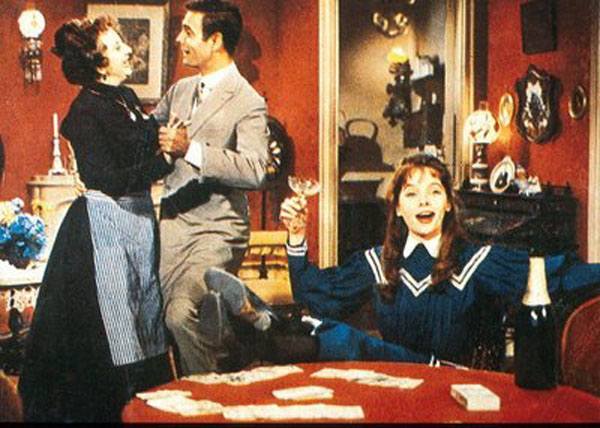
by John Mariani
Now
that New Year's is over--a time when too much good Champage is wasted
in letting it gush onto the floor or being served to throngs who
wouldn't know the difference between French Champagne and German Sekt,
it seems like a good moment to consider Champagne more specifically as
a wonderful wine with a good meal--throughout a good meal.
Anywhere else but in France’s
Champagne district the idea of putting the phrase “blanc de
blancs”—white wine made from white grapes—is a mere redundancy.
True, white wine can be made from red grapes, and most Champagne is
made with pinot noir, sometimes blended with chardonnay.
But
in the Côte de Blancs, where Champagne’s chardonnay is
principally grown, producers, and many connoisseurs, believe that a
Blanc de Blancs is the most delicate and elegant of sparkling
wines. In order to make up my own mind I joined other wine
writers for a tasting of 13 Blanc de Blancs over a four-course lunch at
the increasingly fine Brasserie
restaurant in midtown New York.
What I came away with from the tasting
was that there are certainly differences among the various Champagnes
but that they were very subtle, so that the prices, which ranged from
$40-$270, did not usually indicate superior quality the higher the
price was. Instead, as with most Champagnes, the differences were
more stylistic, with age adding nuance but youth exhibited wonderful
freshness.
My very favorite came about midway in
price—a rich, almost woodsy Charles
Heideick Blanc des Millenaires Brut 1995 ($90), whose aging
proved that older Champagnes need not taken on that slight oxidation
smell and taste that the Brits traditionally favor. The most
expensive, at $270, was Perrier-Jouët
Cuvée Belle Epoque Blanc de Blancs Brut 2000, which
retained sumptuous fruitiness with a balance of citrusy acids that made
it quite a mouthful.
At the reception we were served a Nicholas Feuillatte "Brut Extrem"
($40), the extreme being there was no “dosage,” the French technical
term for sugar liquid added to start the second fermentation, so the
wine was extremely dry, not much to my liking. The same mark’s Blanc de Blancs Brut 1999, at only
$45, was a delight, however, here showing off that fruited finesse that
the chardonnay grape possesses in a vintage year.
A
course of bay scallops with slightly sweet parsnip mousseline and
chervil verjus was well complemented by Mumm de Cramant Grand Cru Brut Chardonnay
($56) and a Ruinart Blanc de Blancs
Brut ($60), both very delicate wines, but a Henriot Blanc Souverain Brut Pur Chardonnay
($46) tasted simply bland.
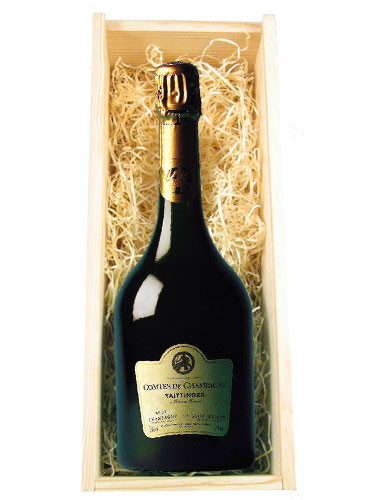 The next flight accompanied a seafood
course of grilled wolfish with green beans and a Champagne beurre
blanc—a sauce with an obvious gastronomic kinship to Champagnes.
The winner with this dish was the $270 Perrier-Jouët, but I found
the opulence of Alfred Gratien Blanc
de Blancs Brut ($90) and Deutz
Blanc de Blancs Brut 2002 ($80) was ideal with a buttery
seafood dish like this. One bottle of Ayala Blanc de Blancs Brut 2000
($66) was corked, but the next was sound, if much too citris to my
taste.
The next flight accompanied a seafood
course of grilled wolfish with green beans and a Champagne beurre
blanc—a sauce with an obvious gastronomic kinship to Champagnes.
The winner with this dish was the $270 Perrier-Jouët, but I found
the opulence of Alfred Gratien Blanc
de Blancs Brut ($90) and Deutz
Blanc de Blancs Brut 2002 ($80) was ideal with a buttery
seafood dish like this. One bottle of Ayala Blanc de Blancs Brut 2000
($66) was corked, but the next was sound, if much too citris to my
taste.
Champagne
with meat dishes is tricky,
but a superbly flavorful veal chop with morel mushroom sauce and sweet
roasted cabocha squash was cooked to bring out all the wintry flavors
without overpowering a glorious Taittinger
Blanc de Blancs Brut Comte de Champagne 1998 ($130)—my favorite
producer making a marvelous example of chardonnay power. The Charles
Heidsieck mentioned above matched the veal dish with its own woodsy
notes, and a Pol Roger Blanc de
Blancs Extra Cuvée de Réserve was mature and
vibrant,
just beginning to fade. (1999) A fairly insipid Louis Roederer Blanc de Blanc Brut 2002
($70) was the fourth wine in the flight.
With a couple of exceptions, I
would gladly drink any of these Champagnes for New Year’s, though I
think they deserve a good meal like the one I had to bring out their
refined virtues. But price should guide such considerations whenever it
comes to wines whose distinctions are in their styles, not necessarily
on their labels.
John
Mariani's weekly wine column appears in Bloomberg Muse News,
from which this story was adapted. Bloomberg News covers Culture from
art, books, and theater to wine, travel, and food on a daily basis, and
some of its articles play on the Saturday Bloomberg Radio and TV.
SO
THAT’S WHERE THEY HID
THE WMD’s!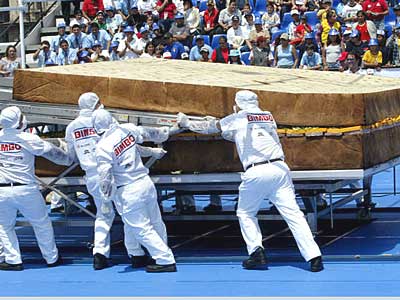
In Tehran, Iranians tried to make the world’s biggest sandwich to get into the Guinness Book of World Records but before an inspector could get there the crowd rushed the chicken-and-ostrich meat sandwich and began to eat it, devouring it all in a matter of minutes. The planners said they had video footage of the sandwich in the hopes Guinness would accept that.
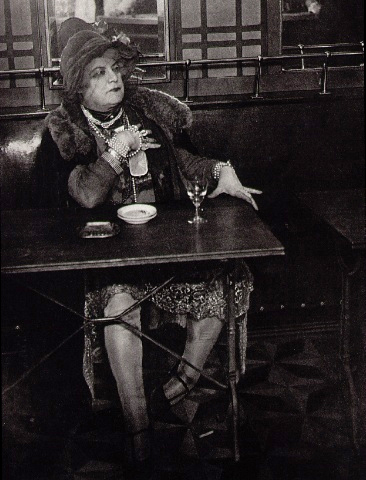 AND
DON'T FORGET THE OLD MEN
AND
DON'T FORGET THE OLD MEN
PISSING AGAINST PARIS MONUMENTS!
“What Paris had lost to modernity was its pungency. Gone was the acrid Gitane-Gauloise pall of any self-respecting café. Gone was the garlic whiff of the early morning Metro to the Place d’Italie. Gone were the mineral mid-morning sauvignon blancs downed bar-side by red-eyed men. . . . Gone were the bad teeth, the yellowing moustaches, the hammering of artisnas, the middle-aged prostitutes in doorways, the seat-less toilets on the stairs, and an entire group of people called the working class.”—Roger Cohen, “Paris-Cuba,” International Herald Tribune (12/8/08).
QUICK BYTES
* In Highland Park, IL, husband and wife team
Carlos and Debbie
Nieto of Carlos' Restaurant host
Carlos and Debbie's Dinner Film Club every second and third Friday of
the month. For $60 pp guests will enjoy a 3-course dinner, a classic
film, and discussion over fresh dessert and coffee. Call 847-432-0770.
Visit www.carlosanddebbiesdinnerfilmclub.com.
* Galette des Rois, the
traditional French cake served on Epiphany, or the Feast of the Three
Kings on Jan. 6, are being made by Patissier Laurent
Dupal at Ceci Cela in
NYC (55 Spring Street; 212-274-9179), until the end of January. They
can be ordered a day in advance for $29.
* On Jan 12 La Cachette
in L.A. will present a 5-course wine pairing dinner
created by Chef/Owner Jean Francois Meteigner, featuring wines of
Jean Chartron Puligny Montrachet.$135 pp. Call 310-470-4992.
Visit www.lacachetterestaurant.com.
* To celebrate London's Victoria & Albert
Museum
“Magnificence of the Tsars” exhibition, The Egerton House Hotel offers
guests a "V&A Tsars package," through March 29, £309 per
night, incl. early check-in, late check-out and guaranteed upgrades;
English breakfast; Vodka martini and caviar blinis with afternoon tea
and pink Champagne; tix to the V&A with access to the
Members' Lounge. Guests staying 2 or more nights in the hotel's V&A
suite receive a complimentary private talk or tour by the exhibition
curators. Call +44 (0)20 7589 2412 or visit www.egertonhousehotel.com.
• * From Jan. 25 – 30 and Feb. 1 – 6,
the second annual dine LA Restaurant
Week will
take place, presented by
LA INC. and the Los Angeles Convention and Visitors Bureau. Dining
experiences will be available in 3 price categories: Deluxe
Dining is $16 for lunch and $26 for dinner; Premier Dining is $22 for
lunch and $34 for dinner, and Fine Dining is $28 for lunch and $44 for
dinner . Visit www.dineLA.com.
* In Colorado Springs, CO, The
BROADMOOR presents the 7th Annual
“Salute to Escoffier” Weekend, Jan. 30-Feb. 1, to benefit the Education
Fund of the Colorado Restaurant Association and The BROADMOOR’s
Culinary Training Program and Scholarship Fund. Friday night:
“Taste of The Broadmoor” welcome reception in the Main Ballroom.,
cooking demos and Grand Buffet. Call 800.634.7711 or visit
www.broadmoor.com.
~~~~~~~~~~~~~~~~~~~~~~~~~~~~~
Everett Potter's Travel Report:

~~~~~~~~~~~~~~~~~~~~~~~~~~~~~~~~~~~~~~~~~~~~~~~~~~~~~~~~~~~~~~~~~~~~~~~~~~
Eating
Las Vegas is the new on-line site for Virtual Gourmet
contributor John
A. Curtas., who since 1995 has been commenting on the Las Vegas food
scene and reviewing restaurants for Nevada Public Radio. He is
also
the restaurant critic for KLAS TV, Channel 8 in Las Vegas, and his past
reviews can be accessed at KNPR.org.
Click on the logo below to go directly to his site.
~~~~~~~~~~~~~~~~~~~~~~~~~~~~~~~~~~~~~~~~~~~~~~~~~~~~~~~~~~~~~~~~~~~~~~~~~~~
Tennis Resorts Online: A Critical Guide to the World's Best Tennis Resorts and Tennis Camps, published by ROGER COX, who has spent more than two decades writing about tennis travel, including a 17-year stretch for Tennis magazine. He has also written for Arthur Frommer's Budget Travel, New York Magazine, Travel & Leisure, Esquire, Money, USTA Magazine, Men's Journal, and The Robb Report. He has authored two books-The World's Best Tennis Vacations (Stephen Greene Press/Viking Penguin, 1990) and The Best Places to Stay in the Rockies (Houghton Mifflin, 1992 & 1994), and the Melbourne (Australia) chapter to the Wall Street Journal Business Guide to Cities of the Pacific Rim (Fodor's Travel Guides, 1991). THIS WEEK: A Report on The Four Seasons Jackson Hole. Click on the logo below to go to the site.

Family Travel
Forum: The
Family Travel Forum (FTF), whose motto is "Have Kids, Still Travel!",
is dedicated to the ideals, promotion and support of travel with
children. Founded by business professionals John Manton and Kyle
McCarthy with first class travel industry credentials and global family
travel experience, the independent, family-supported FTF will provide
its members with honest, unbiased information, informed advice and
practical tips; all designed to make traveling a rewarding, healthy,
safe, better value and hassle-free experience for adults and children
who journey together. Membership in FTF will lead you to new worlds of
adventure, fun and learning. Join the movement.
All You Need to Know Before You Go
~~~~~~~~~~~~~~~~~~~~~~~~~~~~~~~~~~~~~~~~~~~~~~~~~~~~~~~~~~~~~~~~~~~~~~~~~
MARIANI'S VIRTUAL GOURMET NEWSLETTER is published weekly. Editor/Publisher: John Mariani.
Contributing Writers: Robert Mariani,
John A. Curtas, Edward Brivio, Mort
Hochstein, Suzanne Wright, and Brian Freedman. Contributing
Photographers: Galina Stepanoff-Dargery, Bobby Pirillo. Technical
Advisor: Gerry McLoughlin.
Any of John Mariani's books below
may be ordered from amazon.com by clicking on the cover image.
 My
newest book, written with my brother Robert Mariani, is a memoir of our
years growing up in the My
newest book, written with my brother Robert Mariani, is a memoir of our
years growing up in the For those of you who don't think of the Robert and I think you'll enjoy this very personal look at our --John Mariani |
 |
 |
 |
 |
 |
 |
© copyright John Mariani 2009
